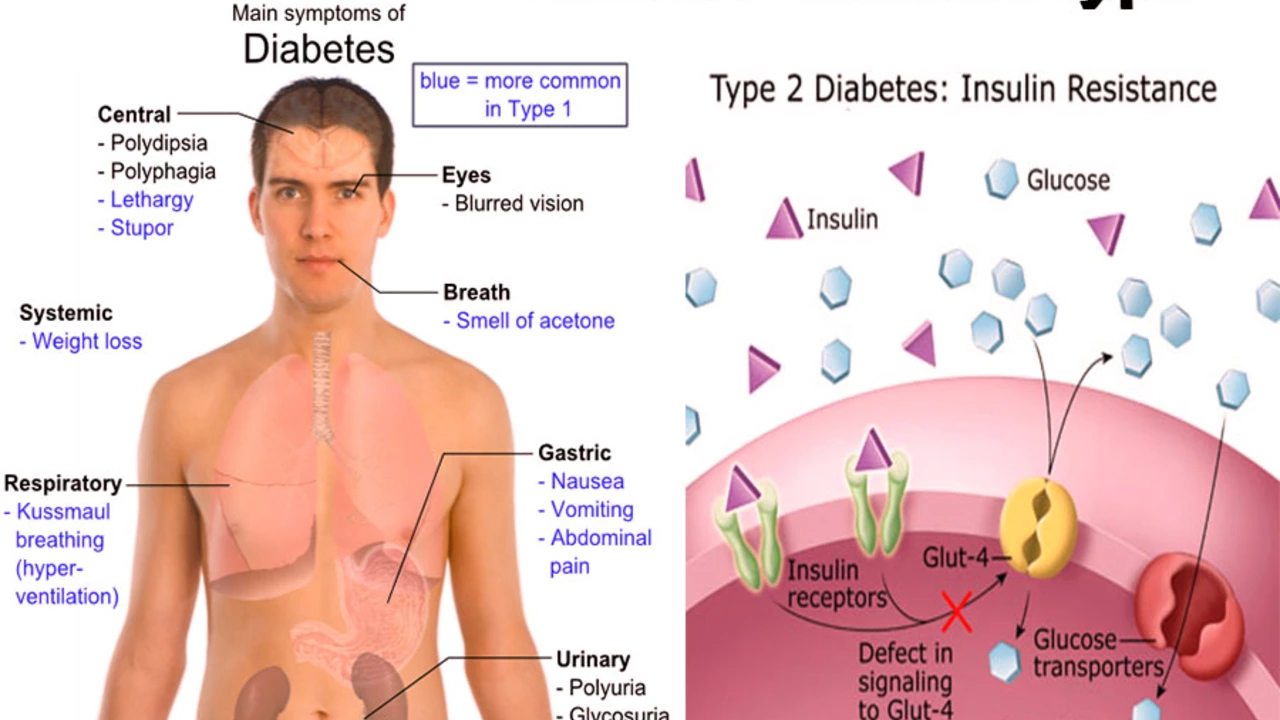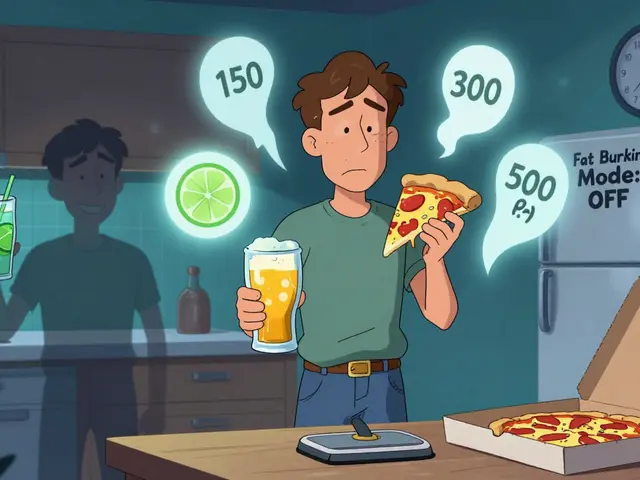
Understanding Diabetes and Its Impact on the Body
Before we delve into the specifics of muscle spasms and diabetes, it's crucial to have a firm understanding of what diabetes is and how it affects the body. Diabetes is a chronic disease that affects how the body uses glucose or sugar. When we eat, our body breaks down the food into glucose, which is then used as fuel by our cells. Insulin, a hormone produced by the pancreas, helps in this process. In people with diabetes, this process is disrupted, resulting in high levels of glucose in the blood. Over time, this can lead to serious health complications, including nerve damage and circulatory problems, which can directly influence muscle health.
The Connection Between Diabetes and Muscle Spasms
Muscle spasms, also known as muscle cramps, are sudden, involuntary contractions of a muscle or group of muscles. They can occur in any part of the body, but are most common in the legs. People with diabetes are more prone to muscle spasms due to high blood sugar levels, which can damage nerves and affect muscle function. This condition is known as diabetic neuropathy, and it's one of the main reasons why people with diabetes experience muscle spasms.
Understanding Diabetic Neuropathy
Diabetic neuropathy is a type of nerve damage that can occur if you have diabetes. High blood sugar levels can injure nerve fibers throughout your body, but diabetic neuropathy most often damages nerves in your legs and feet. This nerve damage can cause a variety of symptoms, including muscle weakness, numbness, and muscle spasms. In severe cases, it can even lead to loss of function in the affected muscles.
The Role of Electrolyte Imbalance
Another factor that can contribute to muscle spasms in people with diabetes is an electrolyte imbalance. Electrolytes are minerals in the body that carry an electric charge and play a crucial role in many bodily functions, including muscle contractions. High blood sugar levels can cause excessive urination, which can lead to loss of electrolytes, such as potassium, calcium, and magnesium. This imbalance can trigger muscle spasms.
Managing Blood Sugar Levels
One of the most effective ways to reduce the risk of muscle spasms if you have diabetes is to manage your blood sugar levels. Regular monitoring, a healthy diet, regular exercise, and taking prescribed medications can help keep your blood sugar levels within a healthy range. It is also important to stay hydrated, as dehydration can contribute to muscle spasms.
Treating Diabetic Neuropathy
Treatment for diabetic neuropathy focuses on slowing the progression of the disease, relieving pain, managing complications, and restoring function. This often involves medications to control pain and other symptoms, physical therapy to improve muscle strength, and devices or procedures to manage complications. In severe cases, surgery may be necessary.
Preventing Electrolyte Imbalance
Preventing electrolyte imbalance is another key strategy in managing muscle spasms in people with diabetes. This involves staying well-hydrated, eating a diet rich in fruits and vegetables, and taking supplements if necessary. It's also important to monitor your electrolyte levels regularly, especially if you have persistent muscle spasms.
When to Seek Medical Attention
While occasional muscle spasms are usually harmless, frequent or persistent spasms can be a sign of a more serious condition. If you have diabetes and experience regular muscle spasms, it's important to seek medical attention. Your healthcare provider can help determine the underlying cause and recommend appropriate treatment options.
Living Well with Diabetes
Living with diabetes doesn't mean you have to live with discomfort or pain. By managing your blood sugar levels, preventing electrolyte imbalance, and treating diabetic neuropathy, you can reduce the risk of muscle spasms and live a healthier, more comfortable life. Remember, it's always important to communicate with your healthcare provider about any new or worsening symptoms.
11 Comments
Sam Rail
July 7, 2023 at 18:51 PM
Nice summary!
Taryn Thompson
July 8, 2023 at 19:51 PM
From a clinical perspective, it is worth emphasizing that electrolyte imbalances, particularly hypomagnesemia, can exacerbate neuropathic pain and contribute to involuntary muscle contractions. While the article correctly highlights the role of potassium and calcium, magnesium often receives less attention despite its critical function in modulating neuromuscular excitability. Routine evaluation of serum magnesium, alongside potassium and calcium, should therefore be incorporated into the management plan for diabetic patients presenting with cramps. Dietary sources such as leafy greens, nuts, and whole grains can help replenish magnesium stores, but supplementation may be necessary in cases of documented deficiency. Moreover, the use of certain diuretics or high‑dose insulin therapy can further deplete electrolytes, necessitating a careful balance between glycaemic control and mineral homeostasis. Encouraging patients to monitor fluid intake and to avoid excessive consumption of caffeine or alcohol, which can promote diuresis, is also advisable. Lastly, patient education regarding early signs of electrolyte disturbance-such as tingling, muscle twitching, or fatigue-can facilitate prompt intervention, potentially averting severe spasms and improving overall quality of life.
Lisa Lower
July 9, 2023 at 20:51 PM
Managing diabetes is like tending a garden you need to water it wisely and pull out the weeds before they get out of hand. First you check your blood sugar regularly it tells you how the soil is doing. Then you eat balanced meals that give steady energy without flooding the ground with sugar. Exercise is the sunshine it helps the roots grow stronger and improves circulation. Staying hydrated is like rain it washes away excess waste and keeps the minerals flowing. If you notice cramps think about potassium magnesium and calcium they are the nutrients that keep muscles relaxed. A quick snack with banana or nuts can restore those electrolytes fast. Don't forget to sleep well it gives the body time to repair nerves and muscles. Keep a log of your symptoms it helps you and your doctor spot patterns. Talk to your healthcare team about any new pain they can adjust meds if needed. Remember small consistent steps lead to big improvements over time.
Dana Sellers
July 10, 2023 at 21:51 PM
Look, if you keep ignoring those cramps you’re just digging your own grave. Simple stuff like drinking water and eating fruit can stop a lot of this nonsense.
Damon Farnham
July 11, 2023 at 22:51 PM
Honestly, the superficial advice in most articles is laughable!!!; you need a rigorous, scientifically‑backed regimen that addresses both glycaemic control and micronutrient replenishment-nothing less!!!; And stop perpetuating the myth that "just hydrate" solves everything!!!; The reality is far more complex, involving insulin sensitivity, renal function, and-most importantly-patient education-!!!
Gary Tynes
July 12, 2023 at 23:51 PM
hey guys i get it its tough but dont forget its all about balance eat right train regular dont skip your meds and stay hydrated its the basics but it works
Marsha Saminathan
July 14, 2023 at 00:51 AM
When you think about the cascade of events that lead from high glucose to muscle cramp you can almost picture it like a fireworks show gone wrong-bright sparks of insulin flare out, then the sudden pop of nerve damage, and finally the clang of a cramped muscle demanding attention. The key is to intercept that chain early, keep the sugar levels steady like a well‑tuned drumbeat, and flood the system with potassium‑rich foods like bananas, oranges, and sweet potatoes that act as soothing lullabies for overstimulated nerves. Hydration, of course, is the backstage crew keeping everything running smoothly, preventing the dehydration‑induced electrolyte tantrum that often ends in a cramp. Even a short walk after meals can act like a gentle breeze, nudging blood flow back into the limbs and wiping away the sticky residue of excess glucose. If you ever feel that tight knot forming in your calf, pause, sip some electrolyte‑enhanced water, and give your body a moment to reset. Over time, these small habits compose a symphony of health that drowns out the discordant notes of neuropathy and spasms.
Justin Park
July 15, 2023 at 01:51 AM
One might ponder whether the muscle spasm is merely a symptom or a subtle warning from the body’s intricate network 🌐. From a philosophical standpoint, the interplay between metabolic imbalance and neuromuscular response invites us to consider the body as a microcosm of larger systems-each component influencing the whole. If we nurture the foundational elements-blood sugar stability, electrolyte harmony, and mindful movement-we may prevent the cascade of discomfort. Hence, the practical takeaway: monitor, hydrate, supplement wisely, and reflect on the deeper lesson that our bodies constantly communicate if we are willing to listen. 🤔
Herman Rochelle
July 16, 2023 at 02:51 AM
Great insights here! Just wanted to add that staying consistent with your glucose checks and keeping an eye on your mineral intake can really make a difference. Keep it up, everyone.
Stanley Platt
July 17, 2023 at 03:51 AM
In summation, the evidence presented elucidates a clear causative link between dysregulated glycaemia and neuromuscular hyperexcitability; therefore, an integrative therapeutic strategy-encompassing precise glycaemic monitoring, electrolyte repletion, and patient education-is unequivocally advocated. 😊






Namit Kumar
July 6, 2023 at 17:51 PM
Diabetes management demands disciplined monitoring of blood glucose, and the correlation with muscle spasms underscores the neuro‑muscular impact of chronic hyperglycaemia. Precise glycaemic control mitigates neuropathic progression, thereby reducing involuntary muscle contractions. In the Indian demographic, dietary carbohydrate load often exacerbates glycaemic spikes, which can precipitate electrolyte disturbances. Maintaining adequate potassium and magnesium levels is essential, as their depletion during osmotic diuresis fuels cramping. Regular physical activity promotes vascular health and nerve regeneration, offering protective benefits against spasms. Consider integrating low‑glycaemic index foods to stabilize post‑prandial glucose excursions. Hydration plays a pivotal role; sufficient fluid intake supports renal clearance of excess glucose and preserves electrolyte balance. Periodic laboratory assessment of serum electrolytes can preempt symptomatic cramping. Patient education on symptom recognition empowers timely medical consultation. Ultimately, a holistic approach encompassing nutrition, exercise, and vigilant monitoring is paramount for mitigating muscle spasms in diabetes :)